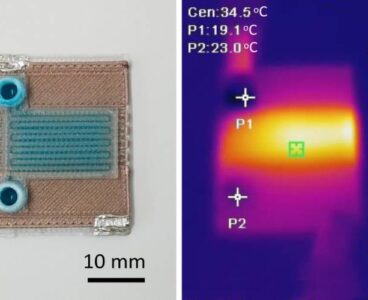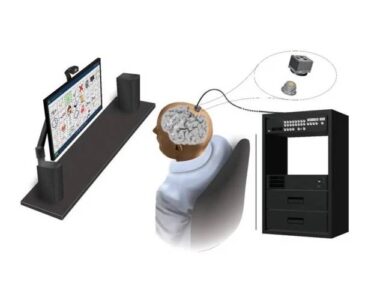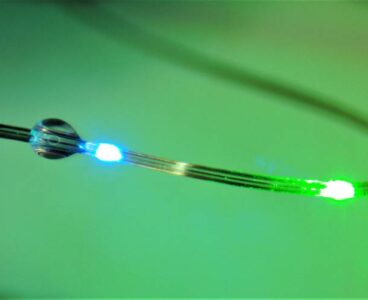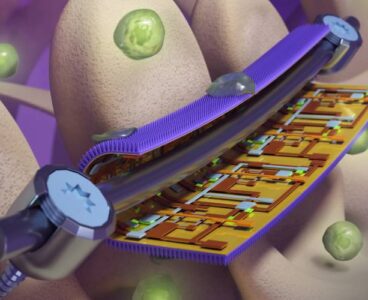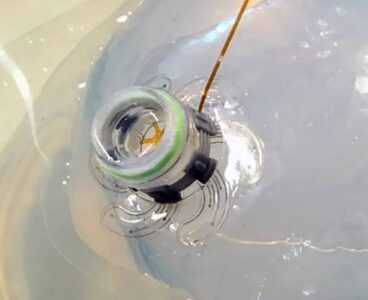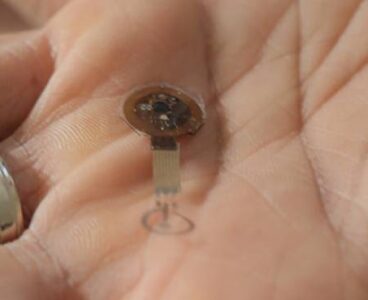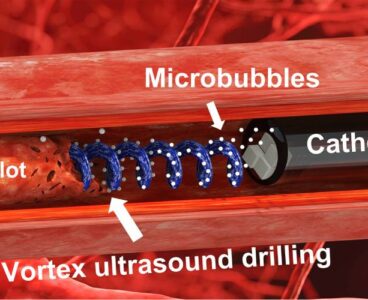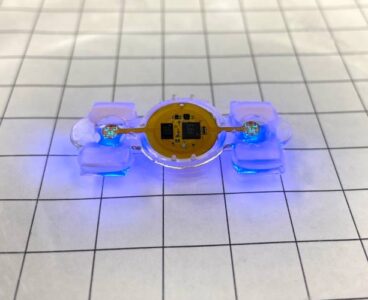Researchers at MIT used 3D printing to create self-heating microfluidic devices, highlighting the potential for this technique in future applications. Microfluidics have uses in detecting diseases within tiny samples of blood or fluids, like in COVID-19 test kits. The team at MIT believes the technique could someday help rapidly create cheap but accurate disease detection…
Brain-computer interface gives patient with ALS control of home devices
Researchers say they observed the successful translation of brain signals into computer commands with a brain-computer interface (BCI) implant. A team at Johns Hopkins surgically implanted the BCI on the brain of an ALS (amyotrophic lateral sclerosis) patient. They published their results, which showed the accurate translation of computer commands from brain activity, in Advanced Science.…
Researchers develop therapy for implant metal poisoning
Researchers say they found a way to protect people from heavy metal poisoning as a result of toxicity from cobalt implants. Cobalt was widely used for hip and knee joint replacements due to strength and durability, but this led to cases of heavy metal poisoning. Toxicity can arise from cobalt and other metals if they…
Robotic hand uses low-cost touch sensors instead of vision
Engineers at the University of California San Diego developed a new approach allowing a robotic hand to rotate objects solely through touch. The UCSD method enables a robotic hand to do so without relying on vision. Using their technique, the engineers built a hand that can smoothly rotate a range of objects, including small toys…
Radiated, ‘humanized’ mice offer insights into implant rejection
Researchers at Johns Hopkins say they discovered an advanced “humanized” mouse model that helps predict the immune system’s reaction to medical implants. The team set out to evaluate why human bodies frequently reject implanted biomaterials, Few ways currently exist to predict this or to prevent it from happening, the researchers said. Joshua Doloff led the…
Why hearing aids might slow cognitive decline in older adults
Results from a clinical trial indicated that hearing aids may play a part in reducing long-term cognitive decline for older adults. According to the University of South Florida, it was the largest randomized, controlled clinical trial testing the efficacy of hearing aids for reducing long-term cognitive decline in older adults. ACHIEVE evaluated patients between ages…
Researchers say this polymer can mimic human muscle in medical devices and robotics
Researchers at Pennsylvania State University said they developed a new ferroelectric polymer that could convert electrical energy into mechanical strain. Such a polymer could offer potential for applications in medical devices, advanced robotics and precision positioning systems. The team says that mechanical strain represents an important property for an actuator. Traditionally, these actuator materials were…
MIT engineers say they can control signals from the brain to the gut
Engineers at MIT say they developed a new technology that can control neural circuits connecting the gut and the brain. Using fibers embedded with sensors, plus light sources for optogenetic stimulation, the researchers demonstrated this control in mice. The study showed that they could induce feelings of fullness or reward-seeking behavior by manipulating cells of…
These magnetically controlled video capsules could provide an endoscopy alternative
Researchers at George Washington University recently tested a method for remotely driving a miniature video capsule into problem areas of the stomach. Medical technology company AnX Robotica created the capsule endoscopy system used in the study, called NaviCam. The company also funded the research. Physicians can direct the capsule to potential problem areas to visualize…
3D-printed wearable sweat sensor could advance home monitoring
Researchers at the University of Hawaiʻi at Mānoa College of Engineering say they developed a 3D-printed, wearable sweat sensor. Called the “sweatainer,” the device harnesses the power of additive manufacturing to enable a new type of wearable sweat sensor. The researchers say the small, wearable device — similar in size to a child’s sticker —…
These smart implant coatings watch for implant failure while killing bacteria
Researchers at the University of Illinois developed “smart” coatings for orthopedic implants that can monitor strain on the devices. These coatings monitor strain to provide early warnings of implant failures while killing infection-causing bacteria. They integrate flexible sensors with a nanostructured antibacterial surface. Researchers say they received inspiration for the surface from the wings of…
Sensor-filled soft robot implant tested for brain monitoring
Researchers say a soft robot inserted through a tiny hole in the skull could offer effective brain monitoring and treatment. The researchers aim to provide a less invasive approach for placing electrodes on the brain’s surface compared to traditional methods. In those traditional methods, surgeons cut a hole in the skull the size of the…
Glowing nanoparticles enhance at-home COVID-19 test sensitivity
Researchers at the University of Houston are using glow-in-the-dark materials to enhance the sensitivity of rapid COVID-19 home diagnostics. The widely used lateral flow assay provides rapid results for diagnostics such as at-home COVID-19 or pregnancy tests. They also offer low costs and ease of operation. Test results on LFA diagnostics come through in colored…
This surgical robotic arm could potentially 3D bioprint inside the human body
Engineers in Australia say they developed a miniature robotic arm that could 3D print biomaterial directly onto human organs. UNSW Sydney researchers developed the flexible, soft robotic arm for 3D bioprinting. This process fabricates biomedical parts from so-called “bioink” to construct natural, tissue-like structures. Predominantly used for research purposes, the process normally requires the use…
Engineers at Northwestern develop electronic bandage that accelerates healing
Northwestern University engineering researchers say they developed a first-of-its-kind small, flexible, stretchable electronic bandage. This bandage accelerates healing by delivering electrotherapy directly to the wound site. It also actively monitors the healing process and harmlessly dissolves — with its electrodes — into the body once no longer needed. The Northwestern McCormick School of Engineering researchers…
Researchers in Hong Kong develop self-charging face mask
A research team at City University of Hong Kong (CityU) says it engineered a breath-to-charge electrostatic face mask. The researchers say the mask can charge itself, continuously replenishing its electrostatic charge as the user wears and breathes through the mask. This increases the filtering performance in prolonged use of the mask for up to four…
IBS researchers develop high-resolution “ultra-thin” endoscope
Researchers at the Institute for Basic Science (IBS) say they developed a high-resolution holographic endoscope system. Choi Wonshik, associate director for the Center for Molecular Spectroscopy and Dynamics (CMSD) within IBS, led the team. According to a news release, the researchers overcame the previous limitation of fiber optic endoscopy. They reconstructed high-resolution images without attaching…
Researchers say ingestible sensor could help with diagnosing GI disorders
Engineers at MIT and Caltech have developed an ingestible sensor that could more easily diagnose gastrointestinal motility disorders. This advance could help with the diagnosis of constipation, gastroesophageal reflux disease and gastroparesis. The engineers designed their tiny sensor to detect a magnetic field produced by an electromagnetic coil located outside of the patient’s body. The…
New ‘ultrasound tornado’ device breaks down blood clots
Researchers at say a new tool and technique using “vortex ultrasound” could potentially break down blood clots in the brain. This sort of ultrasonic tornado eliminated clots formed in an in vitro model of cerebral venous sinus thrombosis (CVST). The researchers, based at North Carolina State University, say it worked more quickly than existing techniques.…
Researchers use microelectronics to develop remote control for ‘biobots’
Researchers at collaborating universities in Illinois developed miniature biological robots with remote control capabilities. The hybrid “eBiobots” combine soft materials, living muscle and microelectronics. Researchers at the University of Illinois Urbana-Champaign, Northwestern University and collaborating institutions developed them. In a post on the University of Illinois website, they described them as centimeter-scale biological machines. They…

